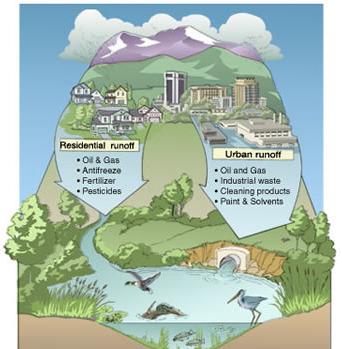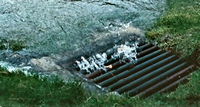Public Works Department
|
60 & 66 Peter Road
Southbury, CT 06488
Maps and Directions
|
P:(203) 262-0622
Monday - Friday:
6:00am - 2:30pm
|
|
Stormwater Program
Stormwater runoff is generated when precipitation from rain and snowmelt events flows over land or impervious surfaces and does not percolate into the ground.
The Public Works Department is an integral partner in Southbury's Stormwater Management Plan. Click to view Southbury Stormwater Management Plan Annual Report 2022.
What is Stormwater?

Stormwater
Stormwater is the rainfall that flows over our yards, streets, parking lots, and buildings and either enters the stormdrain system or runs directly into a lake or stream.
Stormdrains
Stormdrains are the openings you see along curbs and in streets and parking lots. They carry away rainwater and transport it through the drainage system to nearby ponds, lakes and streams, and ultimately to Long Island Sound. Water and other debris that enter stormdrains do not go to a treatment facility.
Sanitary Sewers
A sanitary sewer takes household water and waste from toilets, sinks and showers, and transports it to a wastewater treatment facility. There, the water is treated and can be reused for reclaimed water.
Stormwater Pollution
As stormwater flows over our lawns, driveways and parking lots, it picks up fertilizers, oil, chemicals, grass clippings, litter, pet waste, and anything else in its path. The stormsewer system then transports these pollutants, now in the water, to local lakes and streams, and eventually Long Island Sound. Anything that goes into a stormdrain eventually ends up in our waters.
Stormwater Quality
The health of a stream depends on the quality of the water that flows through it. To care for the stream, we must also care for all the land that drains to it—its watershed.
Everything in the watershed affects the water in the stream. Hazardous chemicals, automotive products, pesticides, fertilizers, pet wastes, excessive soil erosion and air pollution all contribute to water pollution. These pollutants don't have to be dumped directly into the water to cause a problem. They are washed from streets, lawns, roofs and even out of the air by rainfall—eventually ending up in wetlands, streams and lakes.
The storm drain or gutter in the street outside your home carries water into a network of storm drains that lead ultimately to Long Island Sound. Storm drains are separate from the sewer system-which handles wastewater from your sinks, tubs and toilets-and does not go to a treatment plant but into our streams, rivers and lakes.
 Resulting impacts of water pollution can range from the obvious, such as oil floating on the water to losses of wildlife due to habitat destruction that often goes unnoticed.
Resulting impacts of water pollution can range from the obvious, such as oil floating on the water to losses of wildlife due to habitat destruction that often goes unnoticed.
Everyone has a part in protecting our watershed and preventing water pollution. While the contribution of one home to water pollution may be small, the combined effect of an entire neighborhood or city can be substantial. Here are some suggestions:
- Use chemical fertilizers and pesticides sparingly. When applied excessively, they can be washed into a nearby storm drain by your sprinklers or rain-damaging aquatic life. Even lawn clippings contain these pollutants. Leave them on the lawn as natural fertilizer or compost them.
- Keep automobiles in good condition and drive as little as possible. This helps keep oil and air pollution out of water sources. Wash cars at commercial car washes that drain to the treatment plants instead of your driveway that drains to the creeks.
- Dispose of hazardous household wastes such as paints, solvents, used oil and cleaning products properly.
Stormwater Management
The Federal Water Pollution Control Act, popularly known as the Clean Water Act, is a comprehensive statute aimed at restoring and maintaining the chemical, physical and biological integrity of the nation's waters. Enacted originally in 1948, the Act was amended numerous times and was reorganized and expanded in 1972. It continues to be amended almost every year.
Primary authority for the implementation and enforcement of the Clean Water Act rests with the U.S. Environmental Protection Agency (EPA). The Act authorizes water quality programs, requires federal effluent limitations and state water quality standards, requires permits for the discharge of pollutants into navigable waters, provides enforcement mechanisms, and authorizes funding for wastewater treatment works, construction grants and state revolving loan programs, as well as funding to states for their water quality programs.
Southbury's Stormwater Management Plan details the Town's ongoing efforts to proactively pursue the goals embodied in the Clean Water Act. It similarly highlights the steps the Town is taking to comply with the standards set forth by the Connecticut Department of Environmental Protection.
Additional Information